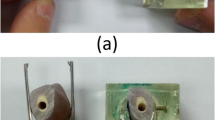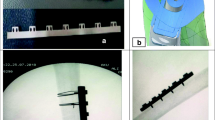Abstract
After osteosynthesis of the proximal humerus by Kirschner wires (K-wire), loosening and secondary loss can occur. This study tested primary fixation of wires made from a shape memory alloy (SMA) Nitinol® (NiTi), compared to conventional steel K-wires by pull-out tests. Blocks of cancellous bone were tested with three wire types: NiTi-K-wire with split apex geometry and conventional steel K-wires with and without threads. We found that NiTi-wires can be pulled out of bone more easily than steel wires (P = 0.05), even though the former had rougher surfaces. The application of NiTi-wires through bone produced no better stability in comparison to normal steel K-wires, because of triggering the memory effect. Further studies are required to determine if NiTi wires of another appropriate design, surface and localization are superior to conventional wires in the context of this application.



Similar content being viewed by others
References
Airoldi G, Riva G (1996) Innovative materials: the NiTi alloys in orthodontics. Biomed Mater Eng 6:299–305
Barber FA, Herber MA, Click JN (1996) Suture anchor strength revisited. Arthroscopy 12:32–38
Brooks C, Revell WJ, Heatly FW (1993) Vascularity of the humeral head after proximal humeral fractures. J Bone Joint Surg (Br) 75:132–136
Gahr R, Thierack C, Kramer G (1986) Percutaneous reconstruction and fixation of closed fractures of the tibial head. Results of a follow-up study. Zentralbl Chir 111(20):1241–1249
Haasters J, Sali-Solio G, Bonsman G (1990) The use of Ni-Ti as an implant material in orthopedics. In: Duerig TW, Melton KN, Stockel D, Wayman CM (eds) Engineering aspects of shape memory alloys. Butterworth-Heinemann, Boston, pp 426–444
Haher TR, Yeung AW, Caruso SA, et al (1999) Occipital screw pullout strength. A biomechanical investigation of occipital morphology. Spine 24(1):5–9
Halder SC, Chapman JA, Choudhury G, Wallace WA (2001) Retrograde fixation of fractures of the neck and shaft of the humerus with the ´Halder humeral nail´. Injury 32:695–703
Jaberg H, Warner JP, Jakon RP (1992) Percutaneous stabilization of unstable fractures of the humerus. J Bone Joint Surg (Am) 74:508–515
Kasai Y, Takegami K, Matsumine A, Kawamoto M, Uchida A (2003) Superelastic Ti–Ni alloy wire intramedullary nails for metastatic femoral pathological fracture: a case report. J Surg Oncol 83:123–127
Khmelevskaya IY, Ryklin EP, Morozova TV (1994) Application of NiTi shape memory effect alloys to X-ray endostenting and other medical fields. In: Pelton AR, Hodgson D, Duerig TW (eds) Proceedings of SMST. Shape Memory and Superelastic Technologies, Pacific Grove, pp 495–498
Kocialkowski A, Wallace WA (1990) Closed percutaneous K-wire stabilization for displaced fractures of the surgical neck of the humerus. Injury 21:209–212
Kujala S, Ryhänen J, Jämsä T (2003) Bone modeling controlled by a nickel-titanium shape memory alloy intramedullary nail. Biomaterials 23:2535–2543
Kumar A, Whittle AP (2000) Treatment of complex (Schatzker Type VI) fractures of the tibial plateau with circular wire external fixation: retrospective case review. J Orthop Trauma 14(5):339–44
Lauritzen JB, Schwarz P, Lund B, et al (1993) Changing incidence and residual lifetime risk of common osteoporosis-related fractures. Osteoporos Int 3(3):127–32
Lerner A, Stein H (2000) Hybrid thin wire external fixation: an effective, minimally invasive, modular surgical tool for the stabilization of periarticular fractures. Orthopedics 27(1):59–62
Lill H, Josten C (2001) Conservative or opertative treatment of humeral head fractures in the elderly? Chirurg 72:1224–1234
Lindemann-Sperfeld L, Pilz F, Marintschev I, Otto W (2003) Fractures of the distal radius. Minimally invasive pin fixation indications and results. Chirurg 74(11):1000–1008
Perren SM (1976) Force measurements in screw fixation. J Biomech 9:669–675
Reynaerts D, Peirs J, Van Brussel H (1995) Production of shape memory alloys for microactuation. J Micromech Microeng 5:1–3
Rubel IF, Seligson D, Lai JL, Voor MJ, Wang M (2001) Pullout strengths of self-reinforced poly-L-lactide (SR-PLLA) rods versus Kirschner wires in bovine femur. J Orthop Trauma 15(6):429–32
Rupf G, Weise K (1987) Temporary bone wire osteosynthesis in fractures of the head of the humerus. Aktuelle Traumatol 17(3):124–30
Sato O, Aoki M, Kawaguchi S, et al (2002) Antegrade intramedullary K-wire fixation for distal radial fractures. J Hand Surg (Am) 27(4):707–13
Shabalovskaya SA (1996) On the nature of the biocompatibility and on medical applications of NiTi shape memory and superelastic alloys. Biomed Mater Eng 6:267–289
Zifko B, Poigenfürst J, Pezzei CH (1992) Intramedullary nailing of unstable proximal humeral fractures. Orthopäde 21:115–120
Acknowledgement
We would like to thank Dr. Paul Kretchmer at San Francisco Edit for his assistance in editing this manuscript. This work was supported by the following grant from the German Ministry of Economics and Research: MedInform®.
Author information
Authors and Affiliations
Corresponding author
Rights and permissions
About this article
Cite this article
Wiebking, U., Gösling, T., Monschizada, W. et al. Do K-wires made from shape memory alloys increase pull-out forces? A preliminary experimental cadaver study in bovine bone. Med Bio Eng Comput 45, 585–589 (2007). https://doi.org/10.1007/s11517-007-0193-y
Received:
Accepted:
Published:
Issue Date:
DOI: https://doi.org/10.1007/s11517-007-0193-y




